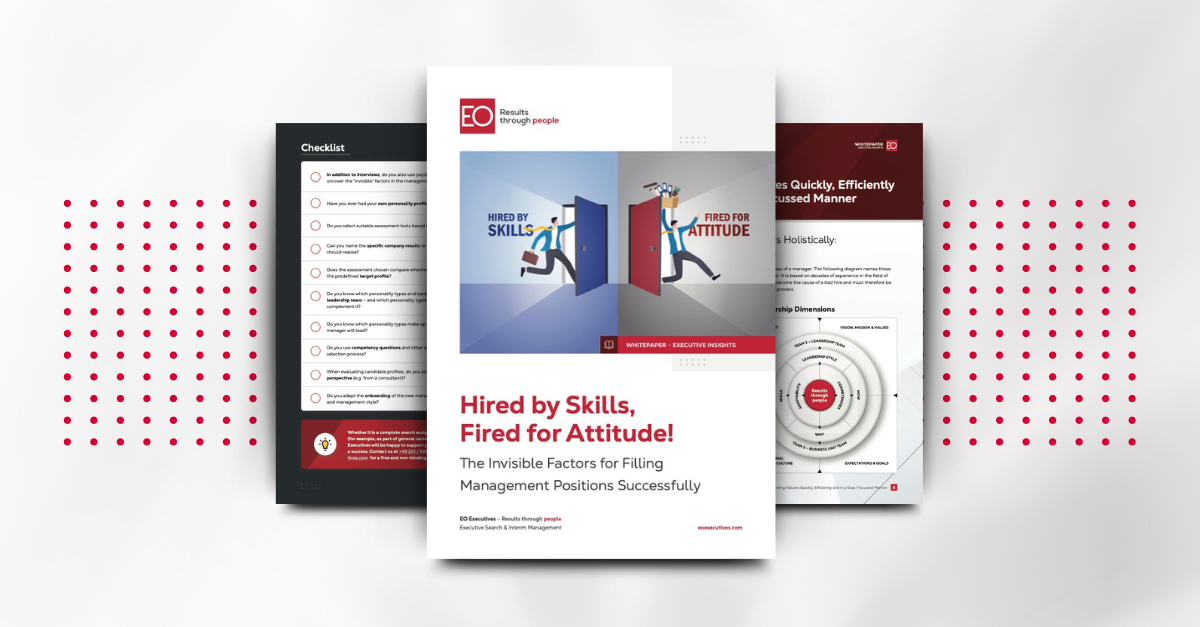Hired by Skills, Fired for Attitude!
Written by Thomas Kollmar & Klaas Koolman on June 6, 2024

Are You Still Haunted by the Last Hiring Mistake?
As the responsible hiring manager, you cannot afford another such failure. The profile of the new vacancy and the required skills are clear. This time, the new manager must fit in with the team and their tasks as a leader. Otherwise, the success and image of the company are at stake and you personally risk your reputation.
However, in the first few weeks after the candidate starts working, disillusionment sets in. You realise that once more, the new leader doesn't fit into the company. In the end, you have to let go of your once-promising candidate. Or, equally frustrating for decision-makers, the initially perfect candidate leaves the company voluntarily.
This can be avoided. Successfully filling a critical management position is not a matter of luck, but rather the interplay of various factors. Some of these factors are obvious – others remain "invisible" without the right tools. But how does one reliably record and interpret these factors? The whitepaper Hired by Skills, Fired for Attitude! The Invisible Factors for Filling Management Positions Successfully reveals how the consultants at EO Executives go about it:
![]()
Whitepaper: Hired by Skills, Fired for Attitude!

The whitepaper can be download free by all interested parties:
The Consequences of the Wrong Decision
According to estimates from Harvard Business Review, the costs of a bad hire can amount to up to three times the annual salary of the position in question. The Bad Hire Calculator provides a detailed breakdown of the costs.
The costs of a new hire consist of direct and indirect expenses. Direct costs include administrative expenses for advertising the vacancy as well as the financial outlay for the selection process. Indirect costs include those for onboarding and allowing the new manager to familiarise themself with the new task.
![]()

»From my perspective, the statement by British-American Simon Sinek hits the mark: 'You don't hire for skill, you hire for attitude. You can always teach skills.' It's all about behaviour, personality, and values – a single bad hire can shake the entire team.«
Klaas Koolman
![]()
As executive search consultants, we encounter two types of clients:
- Some are already aware that soft skills, attitude and emotional intelligence are crucial for the success of a leader within a team or organization.
- Others have not yet realised this. They still hire leaders solely based on their technical knowledge. However, in most cases, technical skills are not the problem when leaders fail in their new positions. The cause usually lies in a mismatch between their motives, values, and behaviours with those of the hiring company, especially the existing team.
![]()

»The right skill profile, gut feeling, and a firm handshake are no longer enough to consistently identify suitable leaders. It is crucial to consider the personality of a candidate. Today's applicants approach job searches more attentively and critically than before. They want to fit into the company.«
Thomas Kollmar
![]()
The Causes of Hiring Mistakes are Clear
The personality of the leader plays a fundamental role in a successful leadership appointment. Selection practices that focus on direct aspects such as the CV, skills and knowledge, largely ignore factors such as motivation, communication skills, emotional intelligence and individual behavioural disposition. However, it is important to be aware of these factors and take them into account during the selection process in order to avoid hiring mistakes.
Are personality traits considered in the selection process?
The personality of the candidate is often neglected in the selection process for new leaders. What makes the candidate tick? Do they fit into the team and the company? If a person's motives and behavioural preferences do not align with the behavioural and motivational requirements of the position or the corporate culture, failure is almost inevitable.
What should the leader fit into?
Often, decision-makers are not clear about what the new manager should actually fit into. Should they align with them personally, the team, or both? What is the team's culture like? How well do the team members work together? And what are their personal traits?
Am I aware of my own perspective in the selection process?
Another point to consider is the hiring manager's blind spots. We all have them. These can be our own biases, preferences, and dislikes that we are unaware of. They influence how we see the world and interact with others. In the hiring process, unconscious motives, behavioral preferences, and motivators can be misleading and potentially cause wrong decisions.
From our perspective as executive search consultants, particularly these last two categories of reasons are given too little attention in the selection process. However, they are becoming increasingly important.
![]()
»When a decision-maker asks me: 'What can we do to ensure that new hires fit better into the leadership team?' Then I'm happy because it shows me that the company's management is on the right track.«
Thomas Kollmar
![]()
Preventing Failures Quickly, Efficiently and in a Goal-Focussed Manner
We are living in a time of societal and economic change. Many companies are undergoing a challenging transformation process. It is more important than ever to sustainably solve "homegrown" problems and remove the metaphorical sand from the gears of the company in order to continue to succeed in the market. For the human resources department, this means avoiding mistakes in filling vacancies and providing leaders with an environment in which they can utilise their abilities optimally.
Awareness for the Behaviour and Motives of Those Involved in the Hiring Process
By using innovative and finely tuned procedures during the selection and hiring phase, decision-makers can obtain a clear picture of the characteristics of each candidate, such as their communication style and behavioural patterns. This makes it possible, for example, to consciously pair an extroverted leader with an introverted manager, who will not be perceived as competition but as support.
Among other methods, EO Executives uses the tools Insights MDI®, Leadership Style Inventory and KODE® KompetenzAtlas to assess the fit of a candidate in relation to the individual management position. The whitepaper Hired by Skills, Fired for Attitude! The Invisible Factors for Filling Management Positions Successfully contains detailed information on the EO approach.
Determining the Profile of a Hypothetical, Ideal Candidate
At the beginning of the hiring process, it is useful to create an ideal profile for the new addition to the leadership team. It helps the decision-maker or hiring manager to determine the factors that are crucial for the successful long-term performance of the new leader. At the same time, the responsible executive search consultant gains information on how the client envisions the ideal candidate.
The Individual Candidate's Personality Profile
This hypothetical, ideal profile is compared with the personality profiles of the individual candidates. This method provides insights into each candidate's motives, preferred behaviour, and general management style. All of these aspects are important for talent recognition in the candidate selection process. The profile also provides information about the optimal environment for the candidate to successfully contribute to the company.
![]()
»The best fit for filling critical key positions can be achieved when the hiring manager also knows their own personality profile. Sharing it with others is a sign of absolute trust. At EO, the consultants put their personal profiles on the table as well.«
Thomas Kollmar and Klaas Koolman
![]()
The Hiring Manager's Personality Profile
During a lunchtime conversation, a board member shared about constant friction among the members of their leadership team. "They're constantly at odds with each other, and things aren't running smoothly. Didn't you mention a tried and tested approach with a personality profile that you've been successfully using for years? I'd like to give it a try myself."
Practical example
- Firstly, the board member determined their personality profile. We thoroughly discussed the results together, thereby creating a foundation and understanding of management diagnostics.
- We managed to persuade the other members of the leadership team of the benefits of the process. We openly discussed the outcomes of individual analyses within the team.
- In the following period, understanding grew regarding one's own behaviour as well as the behaviour of other members of the leadership team. The measures implemented to reduce conflicts within the team began to take effect. The conflicts no longer dominated the team's everyday life, and the energy previously consumed by those conflicts was now available for achieving common goals.
And if a conflict arises now, it can be resolved more swiftly. At that point, you might hear lighthearted remarks from team members experienced with personality diagnostics, such as: "I understand your reaction. You're a red/yellow/green/blue person." (In the Insights MDI® diagnostic model, the four colours or mixtures of them stand for certain personality characteristics).
You can find more information on the assessments used by EO Executives in the whitepaper Hired by Skills, Fired for Attitude! The Invisible Factors for Filling Management Positions Successfully:
![]()
Whitepaper: Hired by Skills, Fired for Attitude!

The whitepaper can be download free by all interested parties:
Our Recommendations to Hiring Managers and Decision-makers
Don't risk your success and reputation in the process of selecting new leaders. Ensure clarity for yourself and your candidates. As executive search professionals, we recommend you ...
- to define a hypothetical, ideal profile for the new manager,
- to establish a profile of the personality of each applicant in question and
- to establish a profile of yourself.
Thanks to innovative and tried-and-tested management methodology, it has become possible to put the pieces of the puzzle together and see the whole picture in order to create the best possible leadership team. This makes sure that, alongside the required skills and professional suitability, the mindset and attitude of its members align as well – so no one will be "Hired by Skills, Fired for Attitude!"
The Authors
About EO Executives
Success in companies is made by people
Success in companies is made by people ("Results through people"). Executives play a particularly important role in this. Our mission is to help our clients build the best leadership team they have ever had.
To do this, we bring together our clients with consultants who are highly individual and have specific knowledge. Our consultants are experts in their respective industries and functional areas. Because our consultants have such a high level of expertise, we ensure that success-critical leadership positions are filled quickly, permanently and successfully.
Successful leadership teams through executive-intro®
In addition to competent consultants, our team consists of dedicated researchers and staff – and each brings their extensive knowledge to the search for the perfect executive. Our unique methodical approach, executive-intro®, ensures that our candidates are not only convincing from a professional point of view, but also represent a long-term enrichment for the management team and the company on an interpersonal level.
We call this a ”Perfect Match“.
EO Executives was founded in 1997 and is now present in six countries worldwide with a total of 33 locations. We fill positions with both permanent executives and experts as well as quickly available interim managers for temporary assignments and projects. In addition, we support our clients with further consulting services in the areas of executive search, interim management and leadership development.
